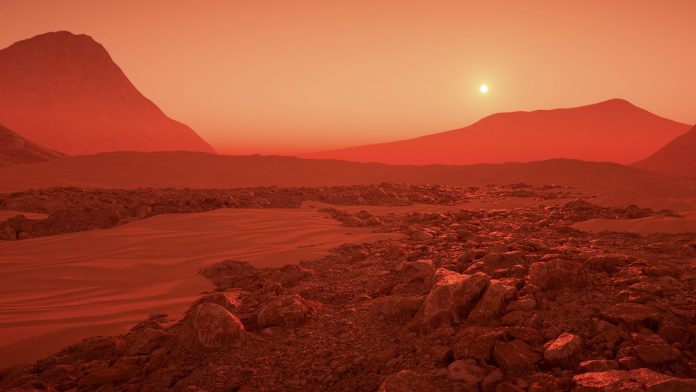A collaborative research team, led by Purdue University, has discovered that mounts of ice in craters provide a new insight into Mars’ climate history.
Newly discovered deposits of layered ice in craters scattered around Mars’ Southern hemisphere indicate that the planet’s orientation has controlled its climate over the past four million years. This discovery means that scientists can now better understand what controlled Mars’ climate history, which is essential for predicting when the planet could have been habitable.
The study was published in the AGU journal Geophysical Research Letters on 29 March 2022.
What happened to Mars’ climate?
Scientists have noted that ice deposits on Mars reflect a combination of temperature, hydrology, and planetary dynamics, as they do on Earth. The planet’s tilt and orbit impact temperature and sunlight on the surface, which contributes to the climate. Thicker, more pure ice layers generally reflect cold periods with more ice accumulation, while thin, dusty layers were likely warmer and less able to build up ice.
Researchers matched these ice layers to the tilt of Mars’ axis and its orbital precession – or how the planet’s elliptical orbit rotates around the Sun over time – with unprecedented resolution and confidence.
The results from this study provided scientists a different insight into how Mars’ climate has altered over time. While the study is limited to Mars’ recent past, establishing these climate-orbit relationships helps scientists in gaining a deeper understanding into Martian climate deeper in the past, which could aid in pinpointing periods of potential habitability.
“It was unexpected how cleanly those patterns matched to the orbital cycles,” explained Michael Sori, lead author and Planetary Scientist at Purdue University. “It was just such a perfect match, as good as you can ask for.”
How has past research contributed to this study?
In previous investigations, Martian climate scientists have focused on polar ice caps, which span hundreds of kilometres. However, researchers have noted that these deposits are old and may have lost ice over time, meaning fine details that are necessary to confidently establish connections between the planet’s orientation and motion and its climate are lost.
Thus, building on this past research, Sori and his team turned to the ice mounds inside the craters, which were just tens of kilometres wide, but much fresher and potentially less complicated. After scouring much of the Southern hemisphere, they pinpointed Burroughs’s crater, which is 74 kilometres wide, and has exceptionally well-preserved layers visible from NASA HiRISE imagery.
The researchers analysed the layers’ thicknesses, as well as their shapes, and discovered that they had strikingly similar patterns to two important Martian orbital dynamics – the tilt of Mars’ axis and the orbital precession, over the last four to five million years.
This discovery is an improvement on previously conducted research, which used Mars’ polar ice records of climate to establish tentative connections to orbit. But those records were too ‘complicated,’ to confidently connect the two. Younger, cleaner crater ice results in less complicated climate records, which the researchers used to match climate changes to orbital precession and tilt with a high level of precision.
How does this aid in our understanding of Mars’ climate?
Discerning the connections that exist between the orbital cycles and Mars’ climate is important for understanding both Martian history and complex climate dynamics on Earth. “Mars is a natural laboratory for studying orbital controls on climate,” Sori commented, because many of the complicating factors that exist on Earth — like biology and tectonics — are negligible on Mars. The whole planet, in essence, isolates the variable for scientists.
“If we are ever going to understand climate, we need to go to places that do not have these interfering factors,” said Isaac Smith, Planetary Scientist at the Planetary Science Institute at York University who was not involved in the study.
“Mars is a pristine planet. And there are a lot of potential applications here. Mars has a lot more in common with Pluto and Triton than you think.”
“Being able to pull a climate signal from a small ice deposit is a really cool result,” added Riley McGlasson, Purdue University scientist, and co-author who applied this method in the new study. “With radar, we can get closer to the full story. That is why I am excited to take this a step further in the future.”
Additionally, it has been noted that not all smaller ice deposits have clean, exposed layers at their surface. Some might be hidden inside the mounds. Sori concluded: “The goal is to sample ice cores like scientists do on Earth, but Mars rovers do not have that capability yet.
“Instead, scientists can use ground-penetrating radar data to ‘peer inside’ the ice and check for layers, making sure visible layers extend throughout the deposit. It is a necessary quality-control step in the present study, and the method may help future explorations of Martian ice without layers visible at the surface.”
To keep up to date with our content, subscribe for updates on our digital publication and newsletter.









